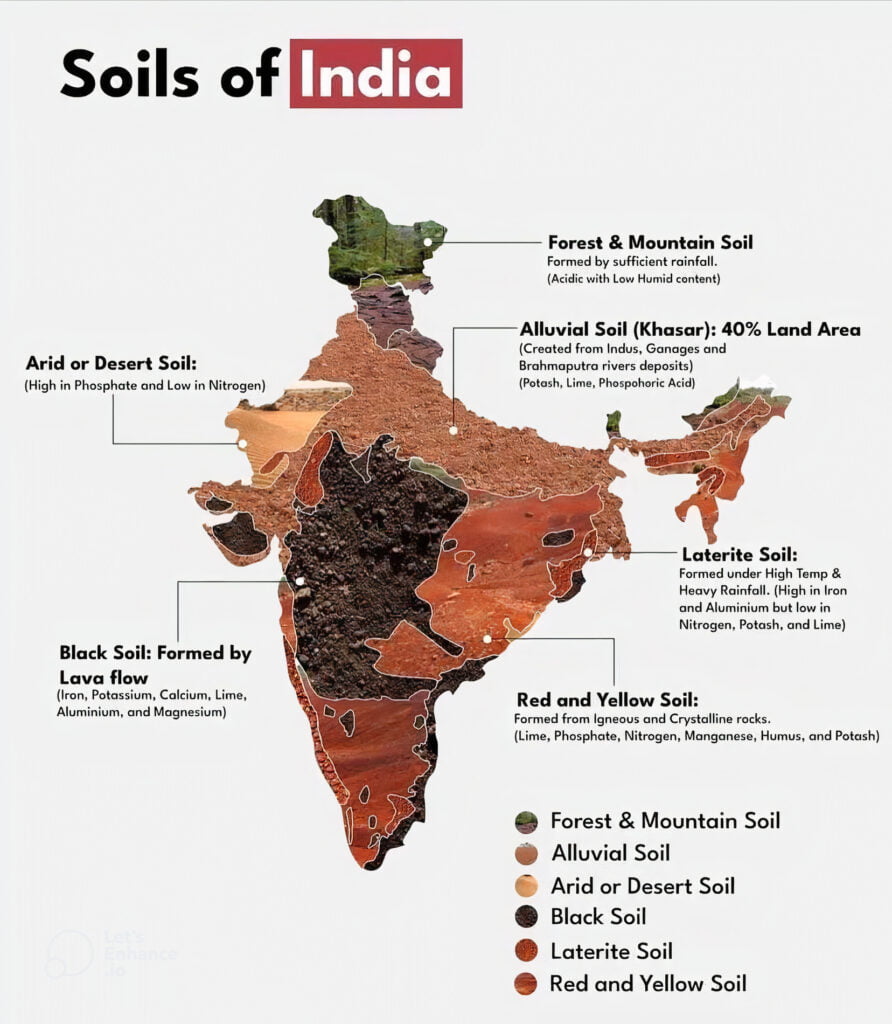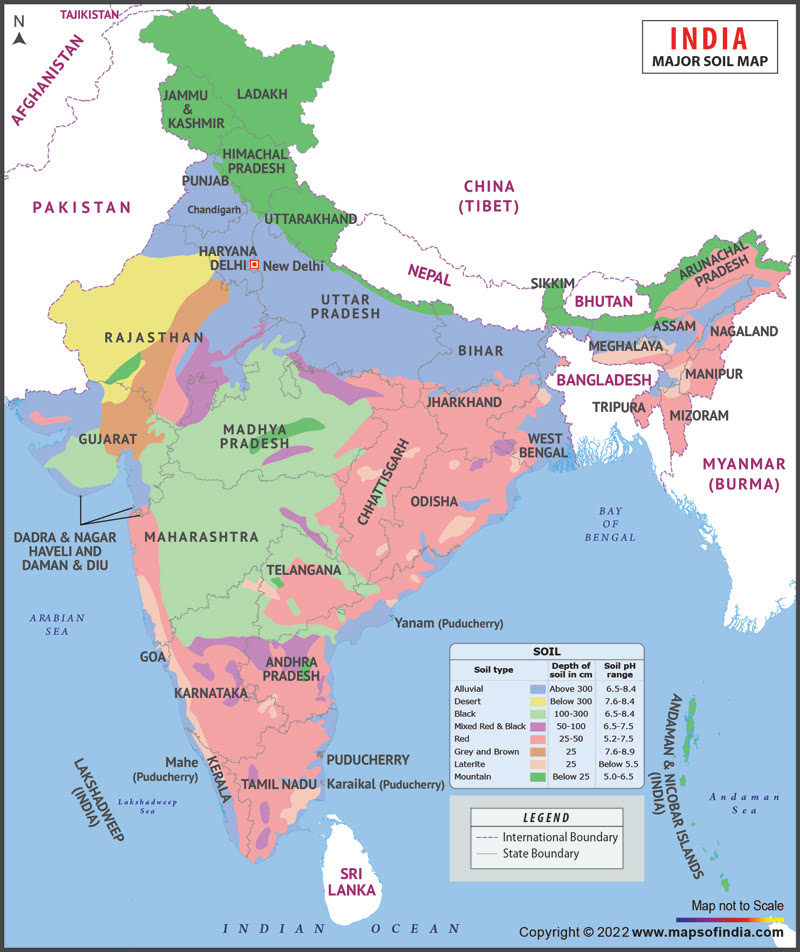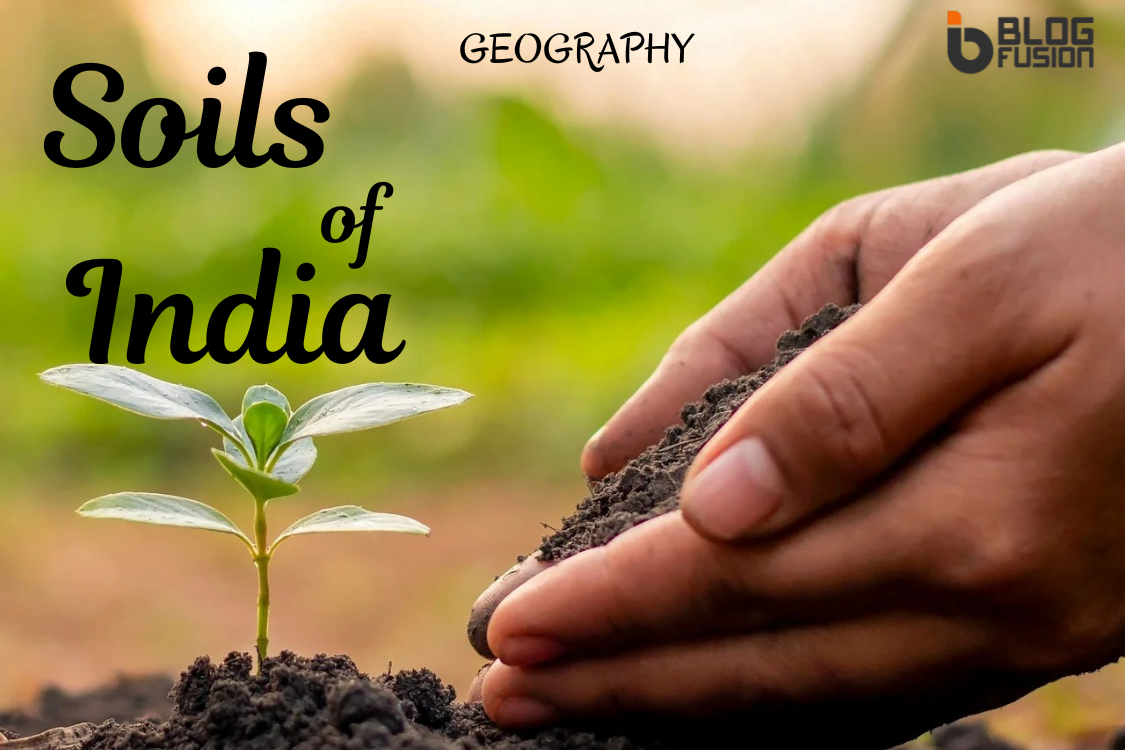India has a diverse range of soils due to its vast geographical expanse, varied climate, and topographic features. Due to the vastness and varied topography of India, the soils of India exhibit a remarkable diversity in composition, fertility, and agricultural suitability. The Indian Council of Agricultural Research (ICAR) classifies them into eight major categories:

1. Alluvial Soil:
- Alluvial soil is the most predominant soil type in India, covering large areas in the Indo-Gangetic plains and along major river valleys. Rivers and streams actively form this landform by depositing silt, sand, and clay.
- Alluvial soil is fertile and ideal for agriculture, making it one of the most agriculturally productive regions in India.
- Indus, Ganga, Brahmaputra, and their tributaries carve through floodplains, leaving behind this type of fertile soil.
- Rich in nutrients and ideal for agriculture.
- Found in the northern plains and coastal regions.
- Formed by the deposition of sediments carried by these rivers, alluvial soil is highly fertile, well-drained, and ideal for agriculture.
2. Black cotton soil(Regur):
- The Decan Plateau region, particularly in Maharashtra, Madhya Pradesh, Gujarat, and some parts of Karnataka, houses black soil, also known as regur soil.
- Rich in minerals like calcium, magnesium, and iron, this soil boasts an impressive capacity to retain moisture.
- Black soil is suitable for growing cotton, cereals, pulses, and oilseeds (cotton, wheat, sugarcane, and jowar).
- Swells when wet and contracts when dry, making it challenging for cultivation.
3. Red and Yellow Soil:
- Tropical regions of eastern and southern India, including Odisha, Chhattisgarh, Andhra Pradesh, West Bengal, Maharashtra, and Tamil Nadu, are home to red and yellow soils.
- The eastern and southern parts of the Deccan Plateau boast this type of soil, which covers about 18.5% of India’s land area.
- The presence of iron oxide paints these soils a characteristic reddish-yellow color.
- While less fertile than alluvial and black soils, red and yellow soils can thrive with proper management. These soils effectively support crops like millets, pulses, oilseeds, and groundnuts.
4. Laterite Soil:
- The original sentence is already in active voice! It clearly states that laterite soil “is found” in specific regions.
- Rich iron and aluminum content paint laterite soil a characteristic reddish hue.
- Heavy rainfall leaches silica away from iron and aluminum oxides in the parent rock, forming laterite soil.
- Laterite soil is infertile due to its low nutrient content and poor water retention capacity.
- Proper soil management techniques can breathe new life into laterite soils, even though they are naturally infertile. They are suitable for crops like cashew nuts, tea, coffee, and rubber.
- It is a good source of building materials like bricks and tiles.
5. Arid or Desert Soil:
- Arid and semi-arid regions like Rajasthan, Gujarat, and parts of Haryana play host to desert soils.
- These soils are sandy and low in organic matter, making them less suitable for agriculture.
- It lacks moisture and organic matter due to scanty rainfall.
- Proper irrigation techniques and soil management practices can unlock the potential for cultivating crops like millets, pulses, and oilseeds in these regions.
6. Saline and Alkaline Soil:
- Arid and semi-arid regions of India face the challenge of saline and alkaline soils, characterized by high concentrations of salts and alkalis.
- These render the soil unsuitable for most crops.
- Soil reclamation techniques like proper drainage and management practices can turn the tide on saline and alkaline soils, bringing them under cultivation.
7. Forest and Mountain Soil:
- The Himalayan region boasts mountain soils, characterized by their high altitude and steep slopes.
- Rich in organic matter due to the decomposition of forest vegetation.
- Good for growing tea, coffee, and spices.
- They are generally shallow, infertile, and prone to erosion. However, they play a vital role in supporting vegetation and maintaining the ecological balance.
8. Peaty and Marshy Soil:
- High rainfall and poor drainage create the perfect conditions for peaty soil formation. In these areas, organic matter accumulates faster than it decomposes.
- Peaty soils are acidic and have a dark color due to the presence of decomposed organic matter (peat).
- Low-lying areas, coastal regions, and wetlands become breeding grounds for marshy soils, characterized by their waterlogged conditions.
- Marshy soils are rich in organic matter and nutrients, but their waterlogged conditions make them unsuitable for most crops.
- It is found in the Sunderbans and other marshy regions of India.
- Rich in organic matter, peaty soil can be used for growing paddy and vegetables after proper drainage.
These are the major soil types found in India, each with its own characteristics and suitability for agriculture. Soil conservation and management practices play a crucial role in sustaining soil fertility and ensuring agricultural productivity in the country.

Frequently Asked Questions (FAQs)
A. Alluvial soil, formed by sediments from rivers, is considered the most fertile due to its good drainage and rich nutrient content.
A. Climate (rainfall, temperature), vegetation, underlying rock formations, and drainage all play a significant role in shaping the type of soil that develops in a particular region.
A. The fertility, drainage, and mineral content of soil significantly influence the crops best suited for cultivation in that area. Farmers need to adopt appropriate practices based on the specific soil type to ensure optimal crop yield.
A. Soil erosion, salinization, and loss of organic matter are some of the major challenges faced in India. Sustainable agricultural practices and soil conservation techniques are crucial to maintain soil health and productivity.
A. The Government of India has launched several programs to promote soil health, including the Soil Health Card Scheme, which provides farmers with information about their soil fertility and recommends suitable amendments.





